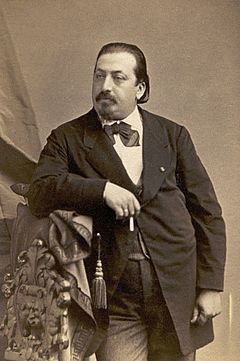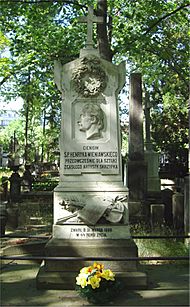Henryk Wieniawski facts for kids
Quick facts for kids
Henryk Wieniawski
|
|
|---|---|
 |
|
| Background information | |
| Born | 10 July 1835 Lublin, Congress Poland |
| Died | 31 March 1880 (aged 44) Moscow, Russian Empire |
| Genres | Romantic |
| Occupation(s) |
|
Henryk Wieniawski (born July 10, 1835 – died March 31, 1880) was a Polish virtuoso violinist and composer. A virtuoso is someone with amazing skill in music. He was also a teacher, known as a pedagogue. Many people think he was one of the best violinists ever.
His younger brother, Józef Wieniawski, was also a talented musician. So was his nephew, Adam Tadeusz Wieniawski. Henryk's daughter, Régine, became a British citizen. She wrote music under the name Poldowski.
Contents
Life Story of a Musical Genius

Henryk Wieniawski was born in Lublin, which is now part of Poland. His father, Tobiasz Pietruszka, changed his name to Tadeusz Wieniawski. He did this to fit in better with Polish culture. Henryk's father became a doctor. He married Regina Wolff, who was the daughter of a famous doctor. Henryk was born from this marriage.
Henryk showed great talent for the violin very early on. In 1843, he was accepted into the Conservatoire de Paris. This is a famous music school in Paris, France. He was taught by Lambert Massart. Henryk was only eight years old, and not French. Special rules were bent so he could join.
He studied at the Conservatoire from 1843 to 1846. He returned for another year in 1849. After finishing school, he traveled a lot. He gave many concerts, called recitals. His brother Józef often played the piano for him. In 1847, Henryk published his first musical work. It was called Grand Caprice Fantastique. This was the start of his many published pieces.
Henryk wanted to marry Isabella Hampton. Her parents did not approve at first. So, Wieniawski wrote a piece called Légende, Op. 17. This beautiful music helped her parents change their minds. Henryk and Isabella got married in 1860.

A famous musician named Anton Rubinstein invited Wieniawski to St. Petersburg. Henryk lived there from 1860 to 1872. He taught many violin students. He also led the Russian Musical Society's orchestra. From 1872 to 1874, Wieniawski toured the United States with Rubinstein. In 1875, Wieniawski became a violin professor. He taught at the Conservatoire Royal de Bruxelles in Brussels.
While living in Brussels, Wieniawski's health got worse. He often had to stop playing during his concerts. In 1879, he started a tour of Russia. But he could not finish it. After a concert, he was taken to a hospital in Odessa. On February 14, 1880, a kind supporter of music, Nadezhda von Meck, took him into her home. She made sure he received medical care. His friends also held a special concert to raise money for his family. He passed away in Moscow a few weeks later. He died from a heart attack. He was buried in the Powązki Cemetery in Warsaw.
His daughter Régine Wieniawski was born in Brussels. She also became a composer. She used the name "Irène Wieniawska" for her early works. After marrying Sir Aubrey Dean Paul, she used the name "Poldowski".
Amazing Musical Works
Henryk Wieniawski was known as a fantastic violinist. He wrote many important pieces for the violin. These include two challenging violin concertos. His second concerto (in D minor, 1862) is played more often than his first (in F-sharp minor, 1853).
His book of studies, L'École moderne: 10 Études-caprices, is very famous. It helps violinists practice difficult techniques. It is one of the oldest sets of studies still played today. His Polonaise Brillante, Op. 4, Scherzo-Tarantelle, Op. 16, and Légende, Op. 17, are also often performed. He also wrote several mazurkas for violin with piano. These pieces use special techniques like plucking strings with the left hand, and playing multiple notes at once.
Lasting Legacy
Henryk Wieniawski received many honors after he passed away. His picture appeared on a postage stamp in Poland in 1952 and again in 1957. A 100 zloty coin was made in 1979 with his image.
There is a way of holding the violin bow sometimes called the "Wieniawski bow hold." He taught his students a very firm way of bowing. This helped him play a special fast, detached style of notes called a "devil's staccato" very easily.
The first violin competition named after Wieniawski happened in Warsaw in 1935. Famous violinists like Ginette Neveu and David Oistrakh won top prizes. The International Henryk Wieniawski Violin Competition has been held every five years since 1952. It is a very important competition for young violinists.
List of Compositions
Henryk Wieniawski wrote many pieces. Here are some of his published works with opus numbers:
- Grand caprice fantastique, Op. 1
- Allegro de Sonate, Op. 2
- Souvenir de Posen, Op. 3
- Polonaise de Concert No. 1, Op. 4 (also known as Polonaise brillante)
- Adagio élégiaque, Op. 5
- Souvenir de Moscow, 2 Russian Romances, Op. 6
- Capriccio-Valse, Op. 7
- Grand duo polonais, for violin and piano, Op. 8
- Romance sans paroles et rondo elegant, Op. 9
- L'École moderne, 10 Études-Caprices, for solo violin, Op. 10
- Le Carnaval Russe, Improvisations and Variations, Op. 11
- 2 Mazurkas de Salon: Sielanka et Piesn Polska (Chanson polonaise), Op. 12
- Fantasie pastorale, Op. 13 (This piece is lost)
- Concerto No. 1 in F♯ minor, Op. 14
- Thème original varié, Op. 15
- Scherzo-Tarantelle, Op. 16
- Légende, Op. 17
- 8 Études-Caprices, for 2 violins, Op. 18
- 2 Mazurkas caractéristiques: Obertass et Dudziarz (Le Ménétrier), Op. 19
- Fantaisie brillante sur Faust de Gounod, Op. 20
- Polonaise brillante, Op. 21
- Concerto No. 2 in D minor, Op. 22
- Gigue in E minor, Op. 23
- Fantasie orientale, Op. 24
He also wrote many pieces that were not published with opus numbers, such as:
- Wariacje na Temat Własnego Mazurka (around 1847)
- Aria with Variations in E major (before 1848)
- Fantasia and Variations in E major (1848)
- Nocturne for solo violin (1848)
- Romance (around 1848)
- Rondo Alla Polacca in E minor (1848)
- Kujawiak in A minor (1853)
- Kujawiak in C major
- Polonaise triomphale
- Rêverie in F sharp minor, for viola and piano
See also
 In Spanish: Henryk Wieniawski para niños
In Spanish: Henryk Wieniawski para niños

